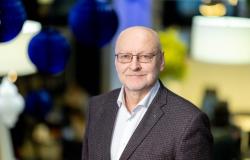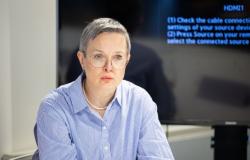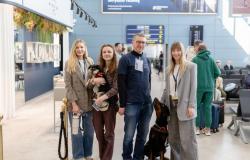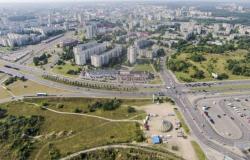An exhibition of media artist and art critic Remigijaus Venckaus, professor of Vilnius Gediminas Technical University, is on display in Šiauliai’s “Laiptų galerija”. A conversation with the artist about creative turns.
– You are an art critic and an artist, as well as a teacher. Maybe you can introduce yourself in more detail and tell us how these different positions fit together?
– Well, among all my various roles, I’ve been an art professor for seven years. I am also a doctor of humanities, art studies. My bachelor’s studies were as a graphic artist, and my master’s was as an art historian. At that time I was studying at Šiauliai University. in 2014 I defended my dissertation in art studies at the Vilnius Academy of Arts. I teach design and communication disciplines in Lithuanian and foreign higher education institutions. Have to work with information technology, humanities and social sciences and arts students. And where else is my activity as a curator of art events. I have curated almost 50 art exhibitions and festivals; maybe I even reached a kind of peak of my career as a curator in 2023. I was the curator of one of the biggest art events in the Balkans, the painting biennial in Zagreb (Croatia). You can also see in my personal biography that the number of organized exhibitions is rapidly approaching 100. I mostly create experimental photography, less often graphic design objects and video films.
– The public knows you well, as you write a lot of articles on art and culture, presenting art exhibitions and artists. However, this year you also started holding painting exhibitions. What inspired you to paint, or perhaps to return to painting?
– This year, there was a turning point in my career, 2024. On March 15, I presented a painting exhibition in Kėdainiai, and here on March 22. – A painting exhibition dedicated to Šiauliai was opened in “Laipų galerija”.
Maybe this is my return to painting. During my undergraduate studies, and later, I painted periodically. However, I have never painted purposefully and programmatically before. Still, the need to paint has been lurking in me for a long time.
Painting is a good and meditation-like activity. Second, the world has gone crazy with technology that generates and regenerates images. Every dilettante can now take photos, film and create music on a computer, telling artificial intelligence how and what a specific audiovisual piece should be generated. It seems like a lot of people have been playing around with these digital tools. Users seem to be mesmerized by the magic of artificial intelligence and are completely unable to tell the difference between the original work and a mash-up of different algorithms. The technological automation of image creation leads to the devaluation of audiovisual creation. Maybe because of this, people with a refined taste turn more and more often to unique, authorial, original art creations.
– Is digital – computer creation already the past of your career?
“Oh, not really.” What am I going to eat if I don’t know how to use digital creation tools anymore?… Most of the disciplines I teach require me to use more than one audiovisual creation tool.
I plan to consistently develop painting, but I will not give up photography at the same time. Digital tools are just as interesting to me as applying paint with a brush. When you clearly form an idea and strive for its implementation, it seems that the idea itself attracts to itself only the means suitable for it. In my studio, which I have set up on the second floor of my house, a computer, a camera, a video camera and an easel with a canvas coexist perfectly.
And at the exhibition in Šiauliai, viewers can also see printed digital painting. I created it in my free time and in those moments when I could not stay in my studio. For example, in 2023 I went to Berlin by bus in the summer. During the trip, I painted several works on the tablet. Another case is in the polyclinic, while waiting for the doctor to come in for a consultation, I also do not let go of the tablet. So, day after day, my computer was filled with works of digital painting. Taking my time and not having a set deadline, I created 26 pieces.
Digital painting is also abstract. The shape of the works is more suggestive of the mood, but I also avoid giving them any name. This is probably why all works are called digital compositions and have their own number and date of creation. Along with these data, I also indicate the city where the work was born. I allow the viewer to imagine what my mood might have been during the creative process and what could have led to such a visual language.
I hope that you can look at my works with an open heart and make your own associations. I do the same when painting with acrylics. First of all, I wanted to call all acrylic paintings simply a composition and indicate its number. But the longer the act of painting is and the more I think about what and how I painted, the more the work itself seems to “confess” what name suits it.
Thus, the paintings are named very associatively, without much pretension to high searches for meaning and existence. For example: “Green line”, “Beach”, “Football field”, “Dogs”, “Rye field”, “Sunny day” and the like. I appreciate and realize more and more that the beauty of the world is in its simplicity. Tell me if it really doesn’t make sense, but at the same time it’s very simple – a waving field of rye, long autumn shadows, a blooming wildflower, the rustle of the forest, the rain slowly pattering on the roof, the creaking of snow… There are many things that can be named, the simple beauty of which is the meaning. So my painting is about meaning in simplicity, maybe even about the meaning of simplicity…
– I understand that you are provoking the viewer by putting your thoughts in this way, but behind the provocation is perhaps something particularly complicated?
– Simple things are usually extraordinary. We don’t realize this until some life crisis hits us, for example, breaking up with a loved one, a serious illness. Life is very wonderful, despite the ups and downs, I am happy with what is around. That’s why I appreciate those simple things too. So this paradox of simplicity and extraordinaryness lies in my works.
However, I want to ask the visitors of my exhibition not to tense up, but to relax. I invite you to come to the exhibition, like a trip full of spectacles, to use painting with your eyes as a pleasant spectacle. I want you to be calm and accept my paintings as another, another form of reflection of reality. Either way, you’ll be right, even if you don’t understand a piece or don’t like a canvas. Come to the painting exhibition as a meditation, to meet yourself and the simple things of reality…






